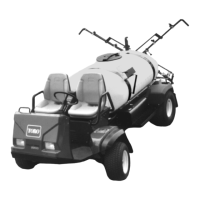35
BELT MAINTENANCE
DRIVE BELTS
The drive belts should be properly adjusted at all
times. A loose drive belt causes improper
alternator, fan and water pump operation, in
addition to overheating. Overtightening the belt
may result in excessive wear on the alternator and
water pump bearings, as well as premature wear
on the belt itself. Therefore, it is recommended
that a belt tension gauge be used to check and
adjust the belt tension. Any belt that has
operated for a minimum of 10 minutes is
considered a used belt, and when adjusted, it
must be adjusted to the reset tension shown in
the specifications below:
ADJUSTING BELTS
Check tension of all belts initially after the first day
of operation and every 100 hours thereafter.
Alternator Belt (Fig. 32)
Belt Tension Specifications
Alternator Tension
New 79-101 lbs.
Used-Reset Minimum 56-75 lbs.
Governor
New 75 lbs.
Used-Reset Minimum 50 lbs.
A used belt is one that has been in operation for 10
minutes or more. Reset belt tension when it meets
minimum specification.
1. To adjust belt tension, loosen bolt securing
alternator brace to engine, bolt securing alternator
to brace and alternator mounting bolt.
2. Insert pry bar between alternator and engine
and pry out on alternator.
3. Hold alternator in position after proper belt
tension setting is achieved and tighten alternator
and brace bolts to secure adjustment.
Governor/Cooling Fan Belt (Fig. 33)
1. To adjust belt tension, loosen upper and lower
nuts securing idler arm to front engine mount.
2. Pull out on idler arm until desired belt tension
is achieved.
3. Tighten mounting nuts to secure adjustment.
Figure 32
1. Alternator Belt 2. Mounting Bolts
Figure 33
1. Governor/Fan Belt Mounting Bolts

